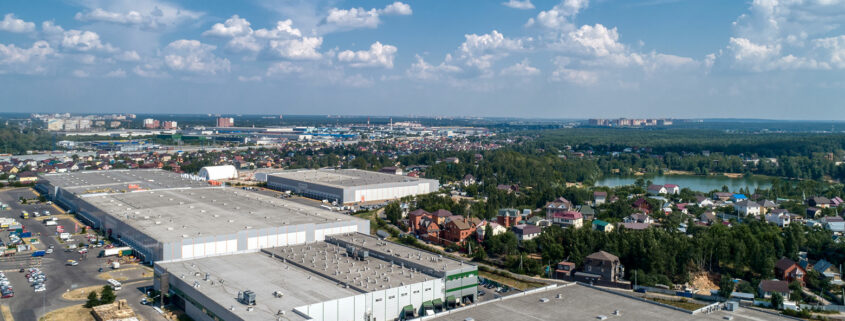The flat roof (or low-slope roof) is one of the most common types of roofs on large commercial buildings. If you’re considering a new roof or need to repair an existing one, you might be wondering why flat roofs are so popular for commercial properties.
Let’s look at the reasons why flat roofs are the norm for commercial buildings and how you can keep your roofing investment well-maintained.
Flat Roof vs. Pitched Roof
A flat roof is also known as a “low-slope” roof because it’s not completely flat. The fact is that all roofs need to have at least a small amount of slope, or pitch, to allow water to drain.
Pitched roofs are more common on residential homes, and typically homeowners lean toward one of two popular choices: asphalt shingles or metal roofing. This type of roof design allows water to run down the slope of the roof, into gutters, and then through downspouts away from the building.
Flat roofs have drainage systems that are often more complex simply due to the amount of water that must be directed off of the roof. Upon installation, roofers use a combination of drains and scuppers.
Drains direct water off of the roof toward downspouts, while scuppers allow water to drain directly off the side of the building. Drain maintenance is key because if drains become blocked by leaves or other debris, water can pool on the roof and eventually cause damage to the commercial roof. Standing water also attracts birds and insects, while promoting plant or algae growth.
Flat Roof Drain Systems
Flat roof drainage systems typically employ one of two systems: gravity systems or siphonic systems.
Gravity systems, like the name suggests, rely on gravity to funnel water through pipes toward downspouts for commercial buildings. However, when a building is the size of an industrial plant or mall, the sheer weight of water on the roof of these buildings can be dangerous. That’s why siphonic systems can be a better choice.
Siphonic systems employ a baffle that prevents air from entering the system, meaning that the pipes have a lower atmospheric pressure than the outside. When water enters the drain, it flows faster than it would by gravity alone. In fact, siphonic systems can drain water up to one hundred times faster than a gravity system!
Flat Roof Size
A flat roof is more suited to large-sized buildings because, by design, they can span larger areas than pitched roofs, which require additional structure. Installing frames large enough to handle a pitched roof on a large commercial building would be a waste of money and impractical.
Flat Roof Cost
Cost is a serious consideration for any business. Despite their enormous size, flat roofs are usually quite straightforward and easy to install. This keeps construction expenses to a minimum, and that savings can be invested back into the business.
Flat Roof Durability
Flat roofs are very durable, and when installed properly, can withstand adverse weather conditions like heavy snowfall and high winds. Their lifespan can last decades, even up to fifty years in the case of a metal roof. However, roof repair may be required from time to time. Building owners should always turn to a professional commercial roofing company for regular maintenance and inspection to ensure the commercial roof reaches its maximum service life.
Flat Roof and HVAC Systems
Flat roofs are an ideal place for the large air conditioning units that are needed to cool large interior spaces. A pitched roof, by comparison, isn’t suited for roof-mounted HVAC equipment.
In most cases, service personnel can perform maintenance and repair to roof-mounted HVAC systems without disturbing customers or employees. This type of HVAC equipment also frees up valuable space inside/around the building, either for additional equipment or retail space.
Flat roofs also allow for easy installation of solar panels. This “green roof” can be especially helpful if you operate in climates where temperatures fluctuate dramatically throughout the year!
Common Flat Roofing Types
Flat roofs are usually constructed from one of several materials like thermoplastic polyolefin (TPO) or modified bitumen. A roofing contractor will be able to assess your building and determine the best, most cost-effective material for your roof.
Single-Layer Membranes
Single-ply roofing options are manufactured roof membranes, such as TPO, PVC or EPDM roofing. These flat roofing materials are roofing technologies developed over the last few decades that can handle temperature changes well due to their elasticity.
Built-up Roof
A built-up roof is the oldest type of flat roofing. Also commonly known as BUR, a built-up roof is made of roofing felt that is applied in multiple layers held together with tar. The layers are applied until the desired thickness is achieved, and then a layer of fine gravel is placed on top to protect the BUR from UV rays and aid in water evaporation.
Modified Bitumen Roofing
Modified bitumen is a modernized version of the old fashioned BUR system. This type of roof is made of asphalt and synthetic rubber or plastic, which is then combined with reinforcing fiberglass to create a structure that is both flexible and waterproof.
TEMA Roofing: Generations of Flat Roof Expertise
If you’re looking for a roofing system that will help your business run more smoothly and efficiently, then contact TEMA Roofing Services. Our experienced team will walk you through the various types of flat roofs for commercial roofing systems and find the option that works best for your business.
In the end, if you’re looking for roof installation, maintenance, repair or commercial HVAC service, TEMA Roofing is your all-in-one source for superior service!





